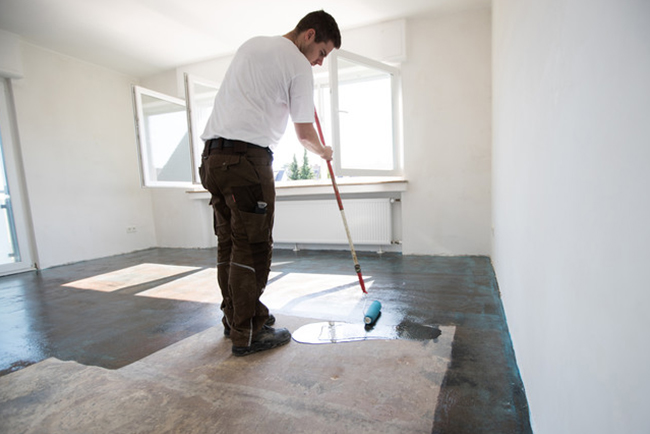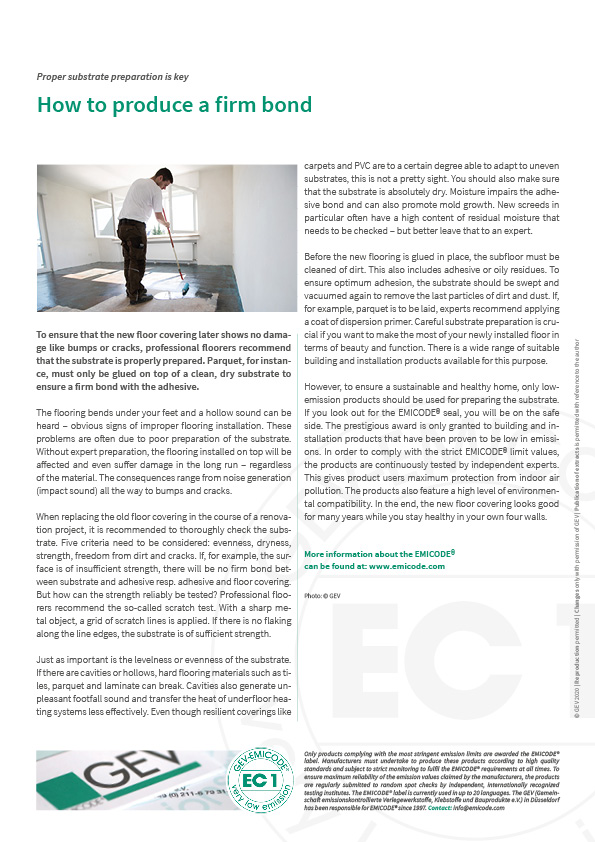How to produce a firm bond
Proper substrate preparation is key
The flooring bends under your feet and a hollow sound can be heard – obvious signs of improper flooring installation. These problems are often due to poor preparation of the substrate. Without expert preparation, the flooring installed on top will be affected and even suffer damage in the long run – regardless of the material. The consequences range from noise generation (impact sound) all the way to bumps and cracks.
When replacing the old floor covering in the course of a renovation project, it is recommended to thoroughly check the substrate. Five criteria need to be considered: evenness, dryness, strength, freedom from dirt and cracks. If, for example, the surface is of insufficient strength, there will be no firm bond between substrate and adhesive resp. adhesive and floor covering. But how can the strength reliably be tested? Professional floorers recommend the so-called scratch test. With a sharp metal object, a grid of scratch lines is applied. If there is no flaking along the line edges, the substrate is of sufficient strength.
Just as important is the levelness or evenness of the substrate. If there are cavities or hollows, hard flooring materials such as tiles, parquet and laminate can break. Cavities also generate unpleasant footfall sound and transfer the heat of underfloor heating systems less effectively. Even though resilient coverings like carpets and PVC are to a certain degree able to adapt to uneven substrates, this is not a pretty sight. You should also make sure that the substrate is absolutely dry. Moisture impairs the adhesive bond and can also promote mold growth. New screeds in particular often have a high content of residual moisture that needs to be checked – but better leave that to an expert.
Before the new flooring is glued in place, the subfloor must be cleaned of dirt. This also includes adhesive or oily residues. To ensure optimum adhesion, the substrate should be swept and vacuumed again to remove the last particles of dirt and dust. If, for example, parquet is to be laid, experts recommend applying a coat of dispersion primer. Careful substrate preparation is crucial if you want to make the most of your newly installed floor in terms of beauty and function. There is a wide range of suitable building and installation products available for this purpose
However, to ensure a sustainable and healthy home, only low-emission products should be used for preparing the substrate. If you look out for the EMICODE® seal, you will be on the safe side. The prestigious award is only granted to building and installation products that have been proven to be low in emissions. In order to comply with the strict EMICODE® limit values, the products are continuously tested by independent experts. This gives product users maximum protection from indoor air pollution. The products also feature a high level of environmental compatibility. In the end, the new floor covering looks good for many years while you stay healthy in your own four walls.

Photo: ©GEV
To ensure that the new floor covering later shows no damage like bumps or cracks, professional floorers recommend that the substrate is properly prepared. Parquet, for instance, must only be glued on top of a clean, dry substrate to ensure a firm bond with the adhesive.

Do You Have Questions?
If you have questions about specific topics or if you would like to contact us for any other reason, feel free to contact us by phone, fax or e-mail.
Phone: +49 211 / 67931-20
Fax: +49 211 / 67931-33
info@emicode.com
Share article on Social Media:
